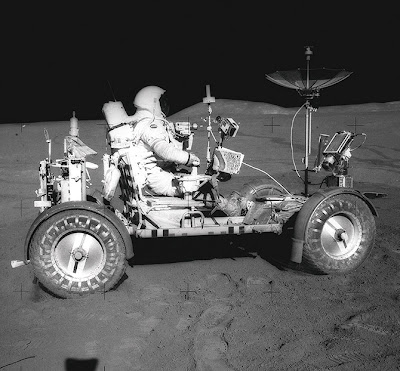Good morning, Whitewater
Our small town’s week end, with a public municipal meeting: The Park and Rec Board’s Starin Park Playground Committee meets today at 1:30 p.m. The agenda is available online.
Wired recalls that on this day in 1971, a first: “Astronauts Drive on the Moon.”
1971: Apollo 15 astronauts David Scott and James Irwin drive the Lunar Roving Vehicle on the surface of the moon. It’s the first off-planet automobile ride.
Forty years after Neil Armstrong made his giant leap for mankind, the Apollo program remains a singular cultural and technological achievement. The application of so much technology to a single goal was nearly without precedent. Amongst all the gadgetry born of the Apollo program, the lunar rover ranks near the top of the cool scale.
The rover was the most famous electric vehicle until that slick little two-seater from Tesla Motors came along, and it remains a technological marvel. The amount of tech packed into that little buggy still boggles the mind….
Boeing built the rover and needed just 17 short months to develop it. Not only did the rover have to carry two men wearing space suits, but it also had to haul whatever rocks and dirt the astronauts found interesting. The main design concerns were, as always, weight and performance.
Cost was not a big concern. The original budget was $19 million for four rovers. Cost overruns — in a government program? I’m shocked, shocked! — doubled the final price tag to $38 mil (worth about $200 million in today’s cash).
The rover didn’t arrive on the moon ready to roll. It was folded like a Transformer and packed into a cargo hold. When the time came, the astronauts used a system of pulleys, reels and tapes to lower the vehicle from the payload bay. After that, the rover took over. Its wheels unfolded automatically and locked into place as the rover opened like an Autobot.
The LRV was 10 feet, 2 inches long with a 7.5-foot wheelbase and a 6-foot tread width. It was less than 45 inches high.
Enemy is the weight of all things that fly, especially those things flying into space. Boeing made the rover supermodel-light. It tipped the scales at a featherweight 463 pounds, a figure that must have made Colin Chapman swoon with envy.
The frame was made of welded 2219 aluminum-alloy tubing. Everything else was aluminum, magnesium or other exotic light alloys. Light, but strong: The little lunar runabout could carry a payload of 1,080 pounds.
The “tires” weren’t tires at all, but zinc-coated woven steel strands attached to the rim and discs of formed aluminum. On top of the zinc and steel mesh were titanium chevrons that covered 50 percent of the contact area to provide traction.
The electric motors — made by GM subsidiary Delco — mounted within the wheels. Each 54-amp DC series-wound motor cranked out 1.9 kilowatts at 10,000 rpm and was attached to its wheel by an 80:1 harmonic drive. The brakes were mechanically operated. Top speed on a smooth, level surface was about 8 mph.
The rover was controlled with a joystick-like T-shaped hand controller located between the two seats. It controlled the four drive motors, two steering motors and brakes. Push it forward and off you went. Pulling back slowed you down. Move the joystick in the direction you wanted to go and the rover turned. It was pretty much like using your Xbox….
On the other hand, it works out to $3.6 million per mile in 2009 dollars. MSRP = Moon Sure Rides Pricey.
Three rovers were left in place on the lunar surface. The fourth was intended for the Apollo 18 mission, which was cancelled. That LRV (one owner, never been used) now lives at the Smithsonian’s National Air and Space Museum in Washington, D.C. The rig on display at the Museum of Flight in Seattle is an original Boeing mock-up.
But as much rocket science as the Lunar Roving Vehicle had packed in it, it still had an owners manual, which you, the taxpayer, can download here.
Source: Various
Photo: Astronaut David Scott in the Lunar Roving Vehicle.
Credit: NASA

Here’s today’s almanac:
| Almanac | ||
|---|---|---|
| Friday, July 31, 2009 | Sunrise | Sunset |
| Official Time | 05:44 AM | 08:17 PM |
| Civil Twilight | 05:12 AM | 08:49 PM |
| Tomorrow | 05:45 AM | 08:15 PM |
| Tomorrow will be: | 3 minutes shorter | |
| Amount of sunlight: | 14h 33m | |
| Amount of daylight: | 15h 37m | |
| Moon phase: | Waxing gibbous | |
